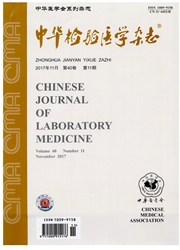

 中文摘要:
中文摘要:
目的获取凝固酶阴性葡萄球菌(CoNS)在神经外科术后感染方面实验室检查指标的贡献与最佳诊断值,优化感染诊断标准。方法回顾性分析2013至2015年首都医科大学附属北京天坛医院神经外科术后感染CoNS的患者脑脊液标本650份,采用传统培养法,统计其流行病学数据且测试8项常规临床实验室检查指标,利用t检验比较判断感染组与污染组在8项指标中具有统计学差异的项目,绘制受试者工作特征(ROC)曲线,得出曲线下面积(AUC),最佳诊断值及相应的敏感度、特异度等。结果共收集脑脊液标本19 756份,CoNS共650株,分离率为3.3%,为分离率最高的细菌。感染组与污染组脑脊液白细胞计数(3 598.6±1 884.3,678.1±629.1,t=2.662,P=0.012),脑脊液多核细胞所占比例(76.0±32.6,46.8±29.9,t=9.593,P=0.001)、脑脊液葡萄糖浓度/血葡萄糖浓度(0.3±0.16,0.63±0.31,t=-11.968,P=0.000)、脑脊液葡萄糖浓度(5.9±2.12,6.2±1.92,t=-16.296,P=0.001)等差异具有统计学意义;ROC曲线显示,脑脊液白细胞计数、脑脊液葡萄糖浓度/血葡萄糖浓度与脑脊液葡萄糖浓度的AUC均大于0.8,3项指标的敏感度均大于80.0%,脑脊液葡萄糖浓度/血葡萄糖浓度与脑脊液葡萄糖浓度的特异性也大于90.0%。结论神经外科术后感染CoNS分离率最高,且脑脊液白细胞计数、脑脊液葡萄糖浓度/血葡萄糖浓度与脑脊液葡萄糖浓度可作为优化CoNS在神经外科术后真感染方面的辅助诊断指标。
 英文摘要:
英文摘要:
ObjectiveTo study on the contribution and cut-off value of coagulase negative staphylococcus (CoNS) in laboratory tests of postoperative infection in neurosurgery and optimize the diagnostic criteria of infection.MethodsIt made a retrospective study of 650 cerebrospinal fluid (CSF) specimens from neurosurgical patients, who were infected CoNS in Beijing Tiantan Hospital affiliated to Capital Medical University during 2013-2015. The epidemiological data were collected and 8 routine clinical laboratory tests were performed. T test was used to compare the difference among the groups. By making receiver operating characteristic (ROC) curve, the area under the curve (AUC), cut-off value, sensitivity and specificity were obtained.ResultsA total of 19 756 CSF specimens were collected and 650 CoNS were isolated. The separation rate of CoNS was 3.3% which was the most frequently isolated bacteria. The differences of cerebrospinal fluid white blood cell count(3 598.6±1 884.3, 678.1±629.1, t=2.662, P=0.012), multinucleated cell ratio in cerebrospinal fluid(76.0±32.6, 46.8±29.9, t=9.593, P=0.001), cerebrospinal fluid glucose concentration(5.9±2.12, 6.2±1.92, t=-16.296, P=0.001) and cerebrospinal fluid glucose concentration/blood glucose concentration (0.3±0.16, 0.63±0.31, t=-11.968, P=0.000) among groups were statistically significant. The AUCs of cerebrospinal fluid white blood cell count, cerebrospinal fluid glucose and cerebrospinal fluid glucose/blood glucose were more than 0.8, and the sensitivities of the three indicators were more than 80.0%. In addition, the specificity of cerebrospinal fluid glucose concentration/blood glucose concentration was more than 0.9.ConclusionsCoNS was the main pathogenic bacteria of neurosurgical infections in a hospital. Cerebrospinal fluid white blood cell count, cerebrospinal fluid glucose and the ratio of cerebrospinal fluid glucose and blood glucose could be used for auxiliary diagnosis of CoNS infections in neurosurgical patients.
 同期刊论文项目
同期刊论文项目
 同项目期刊论文
同项目期刊论文
 期刊信息
期刊信息
